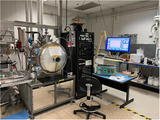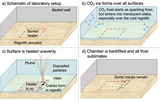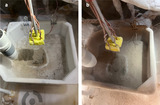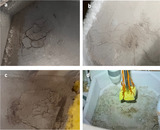Image Details
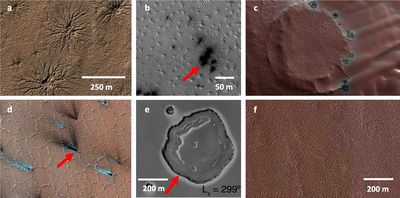
Caption: Figure 1.
Some examples of the “zoo” of features proposed to be formed by seasonal CO2 sublimation dynamics on Mars. (a) “Thin” spiders within the south polar layered deposits, based on HiRISE image ESP_055283_0985, lat = −81.°454, lon = 296.°269, L s = 89°. (b) Dark spots on top of a layer of translucent CO2 slab ice covering a cluster of “fat” spiders at Inca City. HiRISE image ESP_037877_0985, lat = −81.°378, lon = 295.°743, L s = 184.°7. (c) “Fried eggs” showing rings of dark dust surrounded by bright halos. (d) Patterned ground within the high south polar latitudes with dark oriented fans indicative of wind direction and some bright, white fans. HiRISE image ESP_073472_0950, lat = −85.°035, lon = 259.°029, L s = 199.°5. (e) Bright halos surrounding SPRC Swiss cheese depressions (Becerra et al. 2016). HiRISE image PSP_004989_0945, lat = −85.°654, lon = 6.°338, L s = 67°. (f) “Lace terrain,” a type of patterned ground suggested to be polygonally patterned ground later scoured and eroded by surface-flowing CO2 gas from the Kieffer model (Hansen et al. 2011). PSP_002532_0935 at lat = −86.°4 and lon = 99.°016, L s = 181.°1. (HiRISE/Jet Propulsion Laboratory/University of Arizona.)
Copyright and Terms & Conditions
© 2024. The Author(s). Published by the American Astronomical Society.


